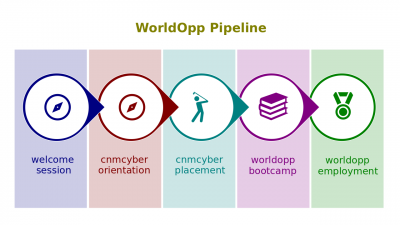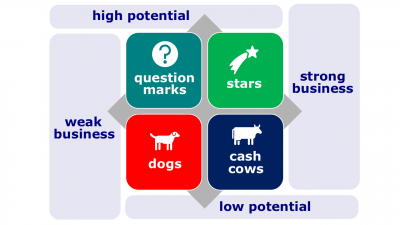|
|
| (42 intermediate revisions by 2 users not shown) |
| Line 1: |
Line 1: |
| − | [[Career Strategies]] (hereinafter, the ''Lectio'') is the second [[lectio|lesson part]] of the '''[[Career Essentials]]''' [[lesson]] that introduces its participants to [[career]]s and related topics. | + | [[Career Effort Portfolios]] (hereinafter, the ''Lectio'') is the second [[lectio|lesson part]] of the '''[[Career Essentials]]''' [[lesson]] that introduces its participants to [[career]]s and related topics. |
| | | | |
| − | [[File:Educaship-pipeline.png|400px|thumb|[[WorldOpp Pipeline]]]]This ''lesson'' belongs to the [[Introduction to Careers]] session of the [[CNM Cyber Orientation]]. The ''Orientation'' is the second stage of the [[WorldOpp Pipeline]]. | + | [[File:Educaship-pipeline.png|400px|thumb|[[WorldOpp Pipeline]]]]This ''lesson'' belongs to the [[Introduction to Careers]] session of [[EmployableU Concepts]]. |
| | | | |
| | | | |
| | ==Content== | | ==Content== |
| − | The predecessor [[lectio]] is [[Career Levels]]. | + | The predecessor [[lectio]] is [[Career Changes]]. |
| − | | + | [[File:Bcg-matrix.png|400px|thumb|right|[[BCG matrix]]]] |
| − | ===Key terms===
| |
| − | :[[File:Bcg-matrix.png|400px|thumb|right|[[BCG matrix]]]]'''[[]]'''.<div style="background-color:#efefef; padding: 5px; margin: 15px;">
| |
| − | </div>
| |
| | | | |
| | ===Script=== | | ===Script=== |
| − | :A [[career strategy]] is a high-level plan to achieve one or more career goals under conditions of uncertainty. No unified ''strategy'' exists; every ''strategy'' depends on what one's [[career goal]]s are. | + | :Every human being needs butter and bread; often, it is hard to find both at the same place. Undertaking different [[career endeavor]]s sounds like a smarter principle than putting all the eggs into the same basket at today's workspace. |
| | | | |
| − | :Reflecting the [[Work Motivation Model]], ''career goals'' may refer to better [[work-life fit]], [[employee compensation]], or [[job task]]s. | + | :A [[career effort portfolio]] is a combination of [[career endeavor]]s, each of which shall have its separate plan of actions. |
| | | | |
| − | :Every ''goal'' may require its own [[career tactic]] to achieve. So, the ''strategy'' can be referred as a composition of ''tactics''. | + | :The [[BCG matrix]] is a tool that [[c-level executive]]s use to formulate their portfolios in the corporate world. With regard to [[career administration]], this ''matrix'' may help in resource allocation decisions on the basis of the [[worker]]'s competitiveness and goal attaining potential of various ''career endeavors''. ''Strong business'' refers to high competitiveness and vice versa. |
| | | | |
| − | :The [[BCG matrix]] is the leading tool that [[c-level executive]]s use to formulate the strategy. With regard to [[career administration]], this ''matrix'' intends to help in resource allocation decisions on the basis of the [[worker]]'s competitiveness and market attractiveness of various career endeavors. | + | :The ''BCG matrix'' positions all the endeavors in one of four quadrants. The matrix creators called weak-business low-potentials ''dogs''; they should be allowed going out. Strong-business low-potentials are ''cash cows''; they should be kept. Weak-business high-potentials are ''question marks''; they might be considered being moved to ''stars'' if ''stars'' are needed. Strong-business high-potentials are ''stars''; they should be nourished. |
| | | | |
| − | :The ''BCG matrix'' positions all the endeavors according to their | + | :How does the ''matrix'' work? Let's imagine a public school [[teacher]], who loves teaching, but looks for more professional flexibility. She says that she has her bread, but also needs some butter. |
| | | | |
| | + | :Under these circumstances, the current job would fit the ''cash cow''. If this teacher launches her own teaching business, that endeavor may fit a ''question mark''. Even if that ''business'' doesn't succeed financially, she would still enjoy doing whatever she wants to do. If the own business is not the best option, this teacher can also try to find appropriate volunteering or a part-time job that would allow more flexibility. At any rate, she would need to revisit her portfolio periodically to adjust it. |
| | | | |
| | + | ===Key terms=== |
| | + | :[[Career effort portfolio]] |
| | | | |
| | + | ===Closing=== |
| | + | :Is the [[concept]] of [[career effort portfolio]] explained well? --Yes/No/I'm not sure |
| | | | |
| − | A career ladder is a metaphor for job promotion.
| + | '''[[What Employability Is]]''' is the successor [[lectio]]. |
| − | | |
| − | A career strategy is any behavior, activity, or experience designed to help a person meet career goals. A career strategy represents a conscious choice by an individual as to the type of investment he or she is willing to make in attempting to reach career objectives. Ideally, people pursue a particular career strategy based on the expectation that it will result in the greatest chances of achieving personal and professional success.
| |
| − | | |
| − | Research on the effectiveness of various career strategies suggests that developing a variety of skills and having a diverse number of work experiences significantly improves one’s chances of attaining career success. Other research has found that the use of strategies such as self-nomination and networking contribute to an individual’s career success. The usefulness of a particular career strategy is dependent on a number of factors, including the nature of the job, the type of the industry, and the culture and norms of the particular organization. Indeed, a career strategy that might be successful in one case might not work in another.
| |
| − | Types of Career Strategies
| |
| − | | |
| − | Past research identifies at least seven general categories of career strategies that can be used to enhance an individual’s chances of career goal fulfillment. The seven strategies include attaining competence in the current job, putting in extended work hours, developing new skills, developing new opportunities at work, attaining a mentor, building one’s image and reputation, and engaging in organizational politics.
| |
| − | | |
| − | Attaining competence in the current job is a basic career strategy, given that organizations make promotion decisions, at least in part, on an employee’s present performance. In addition, the skills acquired or honed in one job might be essential for performance in another job either with one’s current employer or with another organization. The concepts underlying the protean and boundaryless career philosophies make it necessary for individuals to have relevant skills at the times when those skills are required by employers. Focusing on developing abilities in a current job can improve an individual’s chances for employability in the future.
| |
| − | | |
| − | Putting in extended hours either at the work site or at home is a popular career strategy, especially in the early career, when an employee is proving himself or herself to the company. Working beyond normal hours can enhance performance in one’s current job and can signify to the organization that one is committed to the job and capable of taking on large volumes of work. However, putting in extended work hours can also result in negative consequences over the longer term, given that extra work hours during evenings and weekends might impinge on the time a person can spend on family or personal activities.
| |
| − | | |
| − | Developing new skills is a career strategy that involves the acquisition or enhancement of work abilities that either improve performance in the present job or will be required in a subsequent position. Michael Arthur, Priscilla Claman, and Robert DeFillippi have called this strategy “knowing how.” They have noted that skill development can involve formal occupational training as well as experiential learning. Skill development can include activities such as participation in training seminars, degree or nondegree university programs, or attendance at a leadership development workshop. Employees can also develop skills by acquiring additional responsibilities on their current jobs, working with an experienced colleague, or joining occupational associations that sponsor continuing education.
| |
| − | | |
| − | Developing new opportunities at work includes a number of more specific strategies that are designed to increase one’s career options. In their typology, Arthur and his colleagues have referred to this career strategy as “knowing whom.” As an example, self-nomination is a frequently observed strategy that involves the willingness to inform superiors of accomplishments, aspirations, and desired assignments. Self-nomination is intended to enhance one’s visibility and exposure to those in more senior positions within the organization, which can bring recognition, special assignments, and sponsorship. Another relevant career strategy under this category is networking, which involves the identification of and communication with a group of relevant acquaintances and friends who can provide information, advice, and support regarding career opportunities.
| |
| − | | |
| − | Attaining a mentor as a career strategy has received considerable attention in recent years. Mentoring can be defined as relationships between junior and senior colleagues or between peers that provide various developmental functions. The mentoring role can be filled by a variety of individuals, not by just one person. A mentor can provide coaching, friendship, sponsorship, and role-modeling to the younger, less experienced protege. In the process, the mentor can satisfy his or her need to have a lasting influence on another person’s life.
| |
| − | | |
| − | Building one’s image and reputation is a career strategy in which the individual attempts to convey an appearance of success and suitability. For example, being married, participating in community activities, and dressing properly can provide a positive public image that can bring career rewards. While this type of strategy is not necessarily important in all or most situations, past research has found that significant numbers of employees make the investment in image building because of the perceived high value to career advancement. Building one’s work reputation is an important strategy because it is presumed that an individual’s past experiences and accomplishments bode well for future performance. Thus, a focus on building a strong work reputation can improve a person’s employability regardless of the employer.
| |
| − | | |
| − | Engaging in organizational politics is somewhat similar to the “knowing why” strategy described by Arthur and his colleagues and covers such diverse activities as agreeing with or flattering one’s supervisor, advocating company practices, not complaining about rules or regulations, and forming alliances or coalitions with others in the organization. More extreme and often personally unacceptable political practices can include sabotaging another person’s work or spreading rumors about a colleague. In many organizations, becoming involved in organizational politics is a career strategy that is necessary for career advancement, although certain behaviors might be viewed as unethical or reprehensible. Nonetheless, regardless of the personal acceptability, engaging in organizational politics is a career strategy that is used regularly.
| |
| − | | |
| − | | |
| − | :[[Career progression]].
| |
| − | :[[Upward career progression]] (within one organization, [[rank promotion]]).
| |
| − | :[[Downward career progression]].
| |
| − | :[[Lateral career progression]].
| |
| − | :[[Diagonal career progression]].
| |
| − | | |
| − | Foot in a door
| |
| | | | |
| − | '''[[Career Tactics]]''' is the successor [[lectio]].
| + | ==Questions== |
| | | | |
| − | ==Quiz== | + | ===Placement entrance exam=== |

